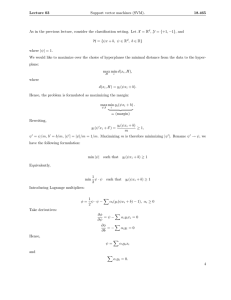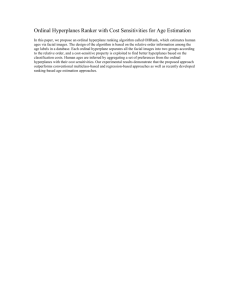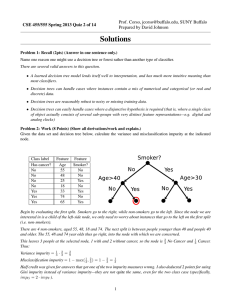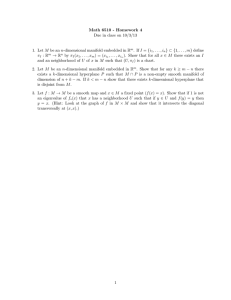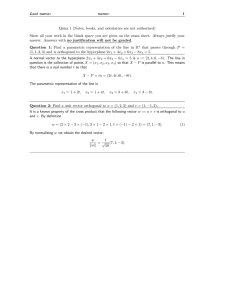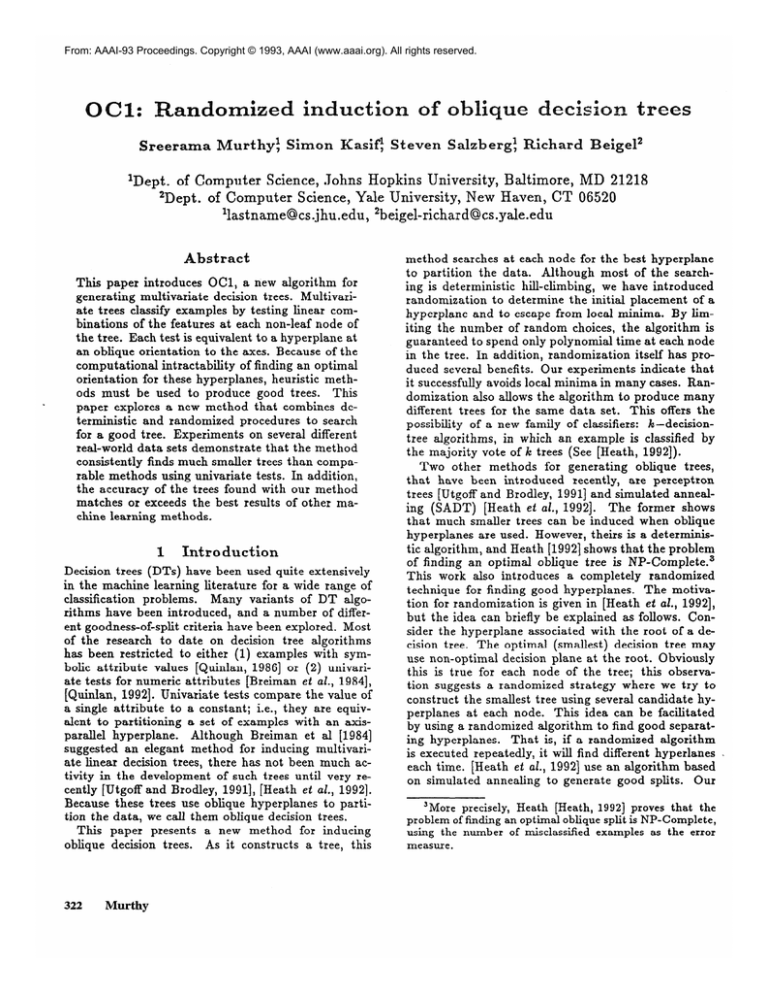
From: AAAI-93 Proceedings. Copyright © 1993, AAAI (www.aaai.org). All rights reserved.
Cl 4
e
Sreerama
Murthy:
e
etio
andomize
Simon
Kasif:
Steven
Salzbergi
ecisio
trees
Richard
lDept. of Comp uter Science, Johns Hopkins University, Baltimore, MD 21218
2Dept. of Co m p uter Science, Yale University, New Haven, CT 06520
‘lastname& s.j hu.edu, 2beigel-richard@cs.yale.edu
Abstract
c
This paper introduces OCl, a new algorithm for
generating multivariate decision trees. Multivariate trees classify examples by testing linear combinations of the features at each non-leaf node of
the tree. Each test is equivalent to a hyperplane at
an oblique orientation to the axes. Because of the
computational
intractability of finding an optimal
orientation for these hyperplanes, heuristic methods must be used to produce good trees. This
paper explores a new method that combines deterministic and randomized procedures to search
for a good tree. Experiments on several different
real-world data sets demonstrate that the method
consistently finds much smaller trees than comparable methods using univariate tests. In addition,
the accuracy of the trees found with our method
matches or exceeds the best results of other machine learning methods.
1
Introduction
Decision trees (DTs) have been used quite extensively
in the machine learning literature for a wide range of
classification
problems.
Many variants of DT algorithms have been introduced, and a number of different goodness-of-split
criteria have been explored. Most
of the research to date on decision tree algorithms
has been restricted to either (1) examples with symbolic attribute values [Quinlan, 19861 or (2) univariate tests for numeric attributes [Breiman et al., 19841,
[Quinlan, 19921. Univariate tests compare the value of
a single attribute to a constant; i.e., they are equivalent to partitioning
a set of examples with an axisparallel hyperplane.
Although Breiman et al [1984]
suggested an elegant method for inducing multivariate linear decision trees, there has not been much activity in the development of such trees until very recently [Utgoff and Brodley, 19911, [Heath et al., 19921.
Because these trees use oblique hyperplanes to partition the data, we call them oblique decision trees.
This paper presents a new method for inducing
oblique decision trees. As it constructs a tree, this
322
Murthy
method searches at each node for the best hyperplane
to partition the data. Although most of the searching is deterministic hill-climbing,
we have introduced
randomization
to determine the initial placement of a
hyperplane and to escape from local minima. By limiting the number of random choices, the algorithm is
guaranteed to spend only polynomial time at each node
in the tree. In addition, randomization
itself has produced several benefits. Our experiments indicate that
it successfully avoids local minima in many cases. Randomization also allows the algorithm to produce many
different trees for the same data set. This offers the
possibility of a new family of classifiers: Ic-decisiontree algorithms, in which an example is classified by
the majority vote of k trees (See [Heath, 19921).
Two other methods for generating oblique trees,
that have been introduced
recently, are perceptron
trees [Utgoff and Brodley, 19911 and simulated annealing (SADT)
[Heath et al., 19921. The former shows
that much smaller trees can be induced when oblique
hyperplanes are used. However, theirs is a deterministic algorithm, and Heath [1992] shows that the problem
of finding an optimal oblique tree is NP-Complete.3
This work also introduces a completely
randomized
technique for finding good hyperplanes.
The motivation for randomization
is given in [Heath et al., 19921,
but the idea can briefly be explained as follows. Consider the hyperplane associated with the root of a decision tree. The optimal (smallest) decision tree may
use non-optimal decision plane at the root. Obviously
this is true for each node of the tree; this observation suggests a randomized strategy where we try to
construct the smallest tree using several candidate hyperplanes at each node. This idea can be facilitated
by using a randomized algorithm to find good separatThat is, if a randomized
algorithm
ing hyperplanes.
is executed repeatedly, it will find different hyperlanes .
each time. [Heath et al., 19921 use an algorithm based
on simulated annealing to generate good splits. Our
3More precisely,
Heath [Heath, 19921 proves that the
problem of finding an optimal oblique split is NP-Complete,
using the number of misclassified examples as the error
measure.
method is also randomized, but it includes a substantial directed search component
that allows it to run
much faster. In our experiments, our method ran much
faster than SADT without sacrificing accuracy in the
resulting classifier.
The algorithmic
content of this paper focusses on
the question of how to partition a given sample space
into homogeneous
regions. A complete description of
any DT building method should also include discussion of its choices regarding the pruning strategies and
the stop-splitting
criteria.
However, we do not address these issues here, because our choices for them
are quite straightforward
and standard in the literature. We stop splitting when the sample space associated with the current node has zero impurity (see
Section 2.4). The only pruning done by our method
consists of cutting off subtrees at nodes whose impurity measure is less than a certain threshold.
For a
good review and comparison of pruning strategies, see
[Mingers, 19891 and [Quinlan, 19921.
The problem of partitioning
the sample space involves the following related issues:
on the location
8 restrictions
planes,
e goodness
and orientation
measures for evaluating
of hyper-
a split,
o strategies to search through the space of possible
hyperplanes for the best hyperplane, and
o methods for choosing
above search begins.
a hyperplane
from which the
These issues are fundamental to the design of a DT algorithm [Breiman et al., 19841, and many existing DT
algorithms can be classified on the basis of how they
make these choices. Section 2 elaborates our algorithm
with respect to each of these issues. Section 3 presents
the results of using our method to classify several realworld data sets, and compares our results to those
of some existing methods.
Section 4 summarizes the
lessons learned from these experiments.
2
The OCI
Algorithm
In this section we discuss details of our oblique decision tree learning method.
We call this algorithm
OCl, for Oblique Classifier 1. OCl imposes no restrictions on the orientation of the hyperplanes.
This
is the main difference between OCl and methods such
as ID3 and CART, which use only axis-parallel hyperplanes. However, OCl cannot distinguish between two
hyperplanes that have identical sets of points on both
sides. In other words, if the sample space consists of
n examples in d dimensions (d attributes),
then our
algorithm recognizes only (:) distinct hyperplanes.
The initial hyperplane at each node in the decision
tree is chosen randomly by OCl. Even if such a randomly placed hyperplane has a very poor location, it is
usually improved greatly in the first few perturbations.
2.1
Search
Strategies
The strategy of searching through the space of possible hyperplanes is defined by the procedure that perturbs the current hyperplane into a new location.
As
there are an exponential number, (i), of possible hyperplane locations, any procedure that simply enumerates all of them will be unreasonably
costly. The two
main alternatives considered in the past have been to
use a non-deterministic
search procedure, as in SADT
[Heath et al., 19921, or to use a heuristic deterministic
procedure, as in CART [Breiman et al., 19841. OCl
combines these two approaches, using heuristic search
until it finds a local minimum, and then using 8 nondeterministic search step to get out of the local minimum.
We will start by explaining how we perturb a hyperplane to split the sample space P at a node of a DT. P
contains n examples, each with d attributes.
Each example belongs to a particular category. The equation
of the current hyperplane H can be written:
kcaiXi )+ ad+1
i=
= 0
1
Let Pj = (Xjl, Xj2,. . ., zjd) be the jth example from
If we substitute
Pj into the
the sample space P.
equation for H, we get: Cfzl(ai2ji)
+ ad+1 = Vj,
where the sign of Vj tells US whether the point Pj
is above or below the hyperplane H. If H splits the
sample space P perfectly, then all points belonging to
the same category in P will have the same sign i.e.,
iff catego?YJ(P;) = CdegOT2J(Pj)
SiCJn(Vj ) = sign(&)
OCl perturbs the coefficients of H one at a time.
If we consider the coefficient a, as a variable, and all
other coefficients as constants, Vj can be viewed as a
function of a,. If Vj is defined as
Uj =
amxjm
-vj
xjrn
(1)
then the point Pj is above H if a, > Vi, and below
otherwise. Thus, by fixing the values of the coefficients
al . . . ad+1, except am, we can obtain n constraints on
the value of Umr using the n points in the set P (assuming no degeneracies).
The problem then is to find a value for a, that satisfies as many of these constraints as possible. (If all the
constraints-are satisfied , then we have a perfect split.)
This problem is easy to solve; in fact, it is just an axis
parallel split in 1-D. The value am, obtained by solving this one dimensional problem is a good candidate
to be used as the new value of the coefficient a,.
ILet
HI be the hyperplane obtained by changing a, to a,,
in H. If H has better (lower) impurity than HI, then
HI is discarded. If HI has lower impurity, HI becomes
the new locatiorl of the hyperplane. If H and HI have
identical impurities, and different locations, then HI is
accepted with probability stag-prob.
Machine Learning
323
Perturb(H,m)
1
forj
= 1 ton
Compute i7+ (Eq. 1)
Sort 771.. . V, m nondecreasing order.
am, = best univariate split of the sorted V’s.
HI = result of substituting am, for am in H.
If (;m~.rity(
H) < impwity(
HI))
stagnant
= 0 3
=%b,;
Else if (impurity(H)
= impwity(.H~))
{ % = am, with probability
stag-p& = e--rtaPnant
= stagnant
+ 1 3
stagnant
3
Figure 1: Perturbation
Algorithm
stag,prob,
denoting
“stagnation
The parameter
probability”,
is the probability
that a hyperplane is
perturbed to a location that does not change the impurity measure. To prevent the impurity from remaining
stagnant for a long time, stag-prob decreases exponentially with the number of “stagnant” perturbations.
It
is reset to 1 every time the global impurity measure is
improved. Pseudocode for our perturbation procedure
is given in Fig. 1.
Now that we have a method for locally improving a
coefficient of a hyperplane, we need a method for deciding which of the d+ 1 coefficients to pick for perturbation. We experimented with three different orders of
coefficient perturbation,
which we labelled Seq, Best,
and R-50:
Seq : Repeat until none of the coefficient values is
modified in the for loop:
For i = 1 to d + 1, Perturb(H, ;)
Best: Repeat until coefficient m remains unmodified :
m= coefficient which when perturbed,
results in the maximum improvement
of the impurity measure.
Perturb(H,m)
R-50: Repeat a fixed number of times :
(50 in our experiments)
m= random integer between 1 and d + 1
Perturb(H,m)
As will be shown in our experiments (Section 3),
the order of perturbation
of the coefficients does not
affect the classification accuracy as much as other parameters, especially the number of iterations (see Section 2.2.2). But if the number ofiterations
and the impurity measure are held constant, the order can have
a significant effect on the performance of the method.
In our experiments, though, none of these orders was
uniformly better than any other.
A sequence of perturbations
stops when the split
324
Murthy
reaches a local
minimum) for
randomization
randomization
minimum (which may also be a global
the impurity measure. Our method uses
to try to jump out oflocal minima. This
technique is described next.
2.2
Minima
Local
A big problem in searching for the best hyperplane
(and in many other optimization
problems, as well) is
that of local minima.
The search process is said to
have reached a local minimum if no perturbation
of
the current hyperplane, as suggested by the perturbation algorithm, decreases the impurity measure, and
the current hyperplane does not globally minimize the
impurity measure.
We have implemented two ways of dealing with local
minima: perturbing the hyperplane in a random direction, and re-running the perturbation
algorithm with
additional initial hyperplanes.
While the second technique is a variant of the standard technique of multiple
local searches, the first technique of perturbing the hyperlane in a random direction is novel in the cant ext
of decision tree algorithms.
Notably, moving the hyperlane in a random direction rather than modifying
one of the coefficients one at a time does not modify
the time complexity of the algorithm.
2.2.1
Perturb coefficients in a random
When a hyperplane H = Cf-,
ai*zi+ad+l
tion
not be improved by deterministic perturbation,
the following.
direccan
we do
Let R = (T~,Q,...,
~d+l) be a random vector. Let
Q be the amount by which we want to perturb H in
the direction R. i.e., Let HI = cf=,
(ai + crri)z; +
(ad+1 + o~d+l) be the suggested perturbation
of H.
The only variable in the equation of HI is cr. Therefore each of the n examples in P, depending on its
category, imposes a constraint
on the value of a
(See Section 2.1). Use the perturbation
algorithm
in Fig. 1 to compute the best value of cr.
If the hyperplane HI obtained thus improves the impurity measure, accept the perturbation.
Continue
with the coefficient perturbation
procedure.
Else
stop and output H as the best possible split of P.
We found in our experiments that a single random
perturbation,
when used at a local minimum, proves
Classification
accuracy improved
to be very helpful.
for every one of our data sets when such perturbations
were made.
2.2.2
Choosing
multiple
initial
hyperplanes
Because most of the steps of our perturbation
algorithm are deterministic,
the initial randomly-chosen
hyperplane determines which local minimum will be
encountered first. Perturbing a single initial hyperplane deterministically
thus is not likely to lead to the
best split of a given dataset. In cases where the random perturbation
method may have failed to escape
from local minima, we thought it would be useful to
start afresh, with a new initial hyperplane.
We use the word iteration
to denote one run of the
perturbation
algorithm,
at one node of the decision
tree, using one random initial hyperplane; i.e., one attempt using either Seq, Best, or R-50 to cycle through
and perturb the coefficients of the hyperplane.
One
iteration also includes perturbing the coefficients randomly once at each local minimum, as described in Section 2.2.1. One of the input parameters to OCl tells
it how many iterations to use. If it uses more than
one iteration, then it always saves the best hyperplane
found thus far.
In all our experiments,
the classification accuracies
Accuracy
increased with more than one iteration.
seemed to increase up to a point and then level off
(after about 20-50 iterations, depending on the domain).
Our conclusion was that the use of multiple
initial hyperplanes substantially improved the quality
of the best tree found.
2.3
Comparison
method
to Breiman
et a1.‘s
Breiman et al [1984, pp. 171-1731 suggested a method
for inducing multivariate decision trees that used a perturbation algorithm similar to the deterministic
hillclimbing method that OCl uses. They too perturb
a coefficient by calculating a quantity similar to Uj
(Eq. 1) for each example in the data, and assign the
new value of the coefficient to be equal to the best
univariate split of the U’s* In spite of this apparent
similarity, OCl is significantly different from the above
algorithm for the following reasons.
Their algorithm does not use any randomization.
They choose the best univariate split of the dataset
as their only choice of an initial hyperplane.
When
a local minimum is encountered, their deterministic
algorithm halts.
Their algorithm modifies one coefficient of the hyperplane at a time. One step of our algorithm can
modify several coefficients at once.
Breiman et al. report no upper bound on the time it
takes for a hyperplane to reach a (perhaps locally)
optimal position. In contrast, our procedure only accepts a limited number of perturbations.
The number of changes that reduce the impurity is limited to
n, the number of examples. The number of changes
that leave impurity the same is limited by the parameter stag-prob (Section 2.1). Due to these restrictions, OCl is guaranteed to spend only polynomial
time on each hyperplane in a tree.4
‘The theorethical
bound on the alnount of time OCl
spends on perturbing
a hyperplane
is O(dn’log
n).
To
guarantee
this bound, we have to reduce atcrgqrob to zero
after a fixed number of changes, rather than reducing it
exponentially
to zero. The latter method leaves an expo-
In addition, the procedure in [Breiman et al., 19841
is at best an outline: though the idea is elegant, many
details were not worked out, and few experiments were
performed. Thus, even without the significant changes
to the algorithm we have introduced, there was a need
for much more experimental work on this algorithm.
2.4
Goodness
of a hyperplane
Our algorithm attempts to divide the d-dimensional
attribute space into homogeneous regions, i.e., into regions that contain examples from just one category.
(The training set P may contain two or more categories.) The goal of each new node in the tree is to
split the sample space so as to reduce the “impurity”
of the sample space. Our algorithm can use any measure of impurity, and in our experiments, we considered
four such measures: information gain [Quinlan, 19861,
max minority, sum minority, and sum of impurity (all
three defined in [Heath, 19921). Any of these measures
seem to work well for our algorithm, and the classification accuracy did not vary significantly as a function of
the goodness measure used. More details of the comparisons are given in Section 3 and Table 2.
2.4.1
Three
new irupurity measures
The impurity measures max minority,
sum minority,
and
sum of impurity were all very recently introduced
in the context of decision trees.
We will therefore briefly define them here.
For detailed comparisons, see [Heath, 19921.
For a discussion
of other
impurity measures, see [Fayyad and Irani, 19921 and
[Quinlan and Rivest, 19891.
Consider the two half spaces formed by splitting a
sample space with a hyperplane H, and call these two
spaces L and R (left and right). Assume that there are
only two classes of examples, though this definition is
easily extended to multiple categories. If all the examples in a space fall into the same category, that space
is said to be homogeneous.
The examples in any space
can be divided into two sets, A and B, according to
their class labels, and the size of the smaller of those
two sets is the minority.
The max minority (MM) measure of H is equal to the larger of the two minorities
in L and R. The sum minority
measure (SM) of H is
equal to the sum of the minorities in both L and R.
The sum of impurity measure requires us to give the
two classes numeric values, 0 and 1. Let Pi, ..) PL be
the points (examples) on the left side of H. Let L”pi be
the category of the point Pi. We can define the average
class avg of L as avg =
cf=
i
CPi
. The impurity
of L is
then defined as CF’.,, (Cp; - avg)2 The sum of impurity
(SI) of H is equal to the sum of the impurity measures
nentially small chance
will be permitted.
In
never perturbed
more
pected runnin g time
appears to be O(Enlog
that a large number of perturbations
practice,
however, hyperplanes
were
than a small (< 12) times. The exof OC1 for perturbing
a hyperplane
n), where k is a small constant.
Machine Learning
325
!- 3
Table 1: Compa
Data
Star
Galaxy
(Bright)
Star
Galaxy
w4
IRIS
Cancer
I
isons with
Accuracy
Method
ax--CSADT
ID3
l-NN
BP
OCl
l-NN
zkCSADT
ID3
l-NN
BP
OCl
CSADT
ID3
l-NN
.-Jz!L
99.2
99.1
99.1
98.8
99.8
95.8
95.1
92.0
98.0
94.7
94.7
96.0
96.7
97.4
94.9
90.6
96.0
,her n ethods
Tree
Size
Impurity
Measure
15.6
18.4
44.3
-
Sl
SI
SI
-
36.0
-
SI
-
-
-
3.0
4.2
10.0
-
-
SI
SM
MM
-
2.4
4.6
36.1
-
SI
SM
SI
-
on both 1; and R.
3
Experiments
In this section, we present results of experiments we
performed using OCl on four real-world data sets.
These results, along with some existing classification
results for the same domains, are summarized in Table 1. All our experiments used lo-fold cross-validation
trials. We built decision trees for each data set using
various combinations
of program parameters (such as
the number of iterations, order of coefficient perturbation, impurity measure, impurity threshold at which a
node of the tree may be pruned). The results in Table 1
correspond to the trees with the highest classification
accuracies.
The results for the CSADT and ID3 methods are
taken from Heath [Heath, 19921. CSADT is an alternative approach to building oblique decision trees that
uses simulated annealing to find good hyperplanes.
These prior results used identical data sets to the ones
used here, although the partitioning into training and
test partitions may have been different. In each case,
though, we cite the best published result for the algorithm used in the comparison.
Star/galaxy
discrimination.
Two of our data sets
came from a large set of astronomical images collected
by Odewahn et al [Odewahn et al., 19921. In their
study, they used these images to train perceptrons and
back propagation
(BP) networks to differentiate between stars and galaxies. Each image is characterized
by 14 real-valued attributes and one identifier, viz.,
Ustar” or ugalaxy”. The objects in the image were divided by Odewahn et al. into “bright” and “dim” data
326
Murthy
Table 2: Effect of parameters
Iter
Imp.
Meas.
1
10
10
20
50
100
1
1
1
1
1
SI
SM
SM
SM
MM
SI
MM
MM
MM
MM
MM
Order
l-7
R-50
Best
seq
R-50
Best
Best
sea
seq
SW
Best
R-50
on accuracv
and DT size
Prune
Thresh.
Act.
Tree
(%I
Depth
T- & Size
10
4
10
8
6
8
0
2
10
10
10
96.4
97.0
96.6
96.8
97.1
96.9
93.7
93.8
92.5
89.2
92.3
3.0,4.9
3.3,4.3
2.3,3.3
3.1,4.3
1.9,2.8
1.9,2.3
6.2,19.6
4.9,14.3
2.9,5.6
3.9,6.7
2.8,5.0
sets based on the image intensity values, where the
“dim” images are inherently more difficult to classify.
The bright set contains 3524 objects and the dim set
contains 4652 objects.
Heath [Heath, 19921 reports the results of applying
the SADT and ID3 algorithms only to the bright images. We ran OCl on both the bright and dim images,
and our results are shown in Table 1. The table compares our results with those of CSADT, ID3, l-nearestneighbor (l-NN), and back propagation
on bright images, and with l-NN [Salzberg, 19921 and back propagation on the dim images.
Classifying irises.
The iris dataset has been extensively used both in statistics and for machine learning
studies [Weiss and Kapouleas, 19891. The data consists of 150 examples, where each example is described
by four numerical attributes.
There are 50 examples in each of three different categories.
Weiss and
Kapouleas
[Weiss and Kapouleas, 19891 obtained accuracies of 96.7% and 96.0% on this data with back
propagation and l-NN, respectively.
Breast cancer diagnosis.
A method for classifying using pairs of oblique hyperplanes was described in
[Mangasarian et al., 19901. This was applied to classify
a set of 470 patients with breast cancer, where each example is characterized by nine numeric attributes plus
the label, benign or malignant. The results of CSADT
and ID3 are from Heath [Heath, 19921, and those of
l-NN are from Salzberg [Salzberg, 19911.
Table 2 shows how the OCl algorithm’s performance
varies as we adjust the parameters described earlier.
The table summarizes results from different trials using the cancer data. We ran similar experiments for all
our data sets, but due to space constraints this table is
shown as a representative. The most important parameter is the number of iterations; we consistently found
better trees (smaller and more accurate) using 50 or
more iterations.
There was no significant correlation
between pruning thresholds and accuracies,
and the
sum minority (SM) impurity measure almost always
produced the smallest (though not always the most
accurate) trees. We did not find any other significant
sources of variation, either in the impurity measure OP
the order of perturbing coefficients.
4
Our experiments
sions:
Conclusions
seem to support
the following
The use of multiple iterations;
i.e.,
ent initial hyperplanes, substantially
formance.
conclu-
several differimproves per-
The technique of perturbing the entire hyperplane in
the direction of a randomly-chosen
vector is a good
means for escaping from local minima.
No impurity measure has an overall better performance than the other measures for OCl. The nature
of the data determines which measure performs the
best.
No particular order of coefficient
perior to all others.
perturbation
is su-
One of OUP immediate next steps in the development
of OCl will be to use the training set to determine the
program parameters (e.g., number of iterations, best
impurity measure for a dataset, and order of perturbation).
The experiments contained here provide an important demonstration of the usefulness of oblique decision
trees as classifiers.
The OCl algorithm produces remarkably small, accurate trees, and its computational
requirements are quite modest. The small size of the
trees makes them more useful as descriptions of the domains, and their accuracy provides a strong argument
for their use as classifiers. At the very least, oblique decision trees should be used in conjunction
with other
methods to enhance the tools currently available for
many classification problems.
Heath, D.; Kasif, S.; and Salzberg, S. 1992. Learning oblique decision trees. Technical report, Johns
Hopkins University, Baltimore MD.
Heath, D. 1992.
A Geometric
.&amework
Ph.D. Dissertation,
Johns
chine Learning.
University, Baltimore MD.
for MaHopkins
Mangasarian, 0.; Setiono, R.; and Wolberg, W. 1990.
Pattern recognition via linear programming:
Theory
and application to medical diagnosis. In SIAM Workshop on Optimization.
Mingers, J. 1989. An emperical comparison of pruning
methods for decision tree induction.
Machine
Learning 4(2):227-243.
Odewahn, S.C.; Stockwell, E.B.; Pennington,
R.L.;
Humphreys,
R.M.; and Zumach, W.A. 1992.
Automated stargalaxy descrimination
with neural networks. Astronomical
Journal 103(1):318-331.
Quinlan, J.R. and Rives& R.L. 1989. Inferring decision trees using the minimum description length principle. Information
and Computation
80:227-248.
Quinlan, J.R. 1986. Induction
chine Learning 1(1):81-106.
Quinlan,
Learning.
of decision
C4.5 Programs
J.R. 1992.
Morgan Kaufmann.
for
trees.
1Ma-
Machine
Salzberg, S. 1991. Distance metrics for instance-based
learning.
In Methodologies
for Intelligent
Systems:
6th International
Symposium,
ISMIS ‘91. 399-408.
Salzberg, S. 1992. Combining learning and search to
create good classifiers. Technical Report JHU-92/12,
Johns Hopkins University, Baltimore MD.
Utgoff, P.E. and Brodley, C.E. 1991. Linear machine
Technical Report 10, University of
decision trees.
Massachusetts, Amherst MA.
Weiss, S. and Kapouleas, I. 1989. An emperical cornparison of pattern recognition, neural nets, and machine learning classification methods. In Proceedings
of Eleventh IJCAI, Detroit MI. Morgan Kaufmann.
Acknowledgements
Thanks
to David
Heath
for helpful
comments.
S. Murthy and S. Salzberg were supported
in part
by the National Science Foundation under Grant IRI9116843.
References
Breiman,
L.; Friedman,
J.H.; Olshen, R.A.;
and
and Regression
Dees.
Stone, C.J. 1984. Classification
Wadsworth International Group.
Fayyad, U. and Irani, K. 1992. The attribute specification problem in decision tree generation.
In Proceedings of AAAI-92,
San Jose CA. AAAI Press. 104110.
Machine Learning
327

